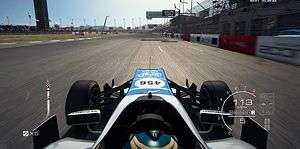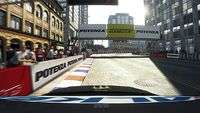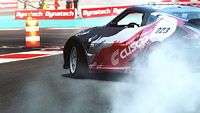GRID Autosport – Preview
by Edward
|
 If there was one thing I never truly understood growing up, it was inter-sport rivalry. Not people arguing over whether Man United or City were best (although that’s still something I don’t quite ‘get’ either), but rather people claiming their preferred sport was better then the rest. I’d watch people argue about rugby versus football day in and out, and woe betide if someone asked me my opinion and found out I preferred motorsports instead.
If there was one thing I never truly understood growing up, it was inter-sport rivalry. Not people arguing over whether Man United or City were best (although that’s still something I don’t quite ‘get’ either), but rather people claiming their preferred sport was better then the rest. I’d watch people argue about rugby versus football day in and out, and woe betide if someone asked me my opinion and found out I preferred motorsports instead.
“But it’s just cars going around in a circle, what’s interesting about that?” they’d claim, and then get unreasonably annoyed when I countered that “Football is just people walking around a field for ninety minutes trying to kick a small ball into a massive net“. If there were ever a company to help disprove their theory, it’d be Codemasters. Over the years they’ve become one of the de-facto companies synonymous with racing games, from the early days of Micro Machines to their present status as the sole developer of F1 titles.
Outside of their now-yearly releases of the self-proclaimed pinnacle of motorsport, they’re also responsible for the GRID series. Originally an offshoot of the TOCA Touring Car games, it’s now evolved into its own franchise, which saw a sequel last year in the form of the aptly-named GRID 2, and an upcoming third instalment in the form of GRID Autosport.
Aiming to tackle the feedback to its predecessor, GRID Autosport feels like a much more serious take on racing, with five different disciplines for players to master over the seasons. First off, there’s Touring, which will be more than familiar to series veterans, and will often feature events where two races will take place – one in qualifying order, then a second where the grid lines up in the reverse order that they finished in the previous race.
 Second, there’s Endurance, which features slightly longer races that also require you to keep a beady eye on your tyre-wear if you want to keep your vehicle on the tarmac. Next up is Open-Wheel, which is probably the most ideal entry point for people who are new to the series but experienced at Codies’ F1 efforts. The Tuner series tasks players with competing in time-attacks and score-attacking Drift events in order to reach the top of the leader-boards, while Street races will see you tackling tight, twisting stages with varying surfaces.
Second, there’s Endurance, which features slightly longer races that also require you to keep a beady eye on your tyre-wear if you want to keep your vehicle on the tarmac. Next up is Open-Wheel, which is probably the most ideal entry point for people who are new to the series but experienced at Codies’ F1 efforts. The Tuner series tasks players with competing in time-attacks and score-attacking Drift events in order to reach the top of the leader-boards, while Street races will see you tackling tight, twisting stages with varying surfaces.
Each discipline will require you to take part in multiple seasons in order to progress through the various levels, with more events being unlocked the more experienced you become. Your levelling is also influenced by your difficulty modifiers, allowing you to receive percentage boosts in return for making the end-experience more difficult. Shutting off options like traction control and ABS will provide a points boost, but upping the AI levels will yield an even-bigger bonus.
In theory, it’s a great idea to encourage people to take more risks in return for less level grinding, but in practice there’s seldom enough of a percentage boost to justify it. Turning off traction control, for example, will only raise your points haul by two percent, so the incentive to soldier on without it is negligible enough that you’re more likely to progress by keeping it on and reaping the benefits of finishing higher on the leaderboards instead.
 |
 |
 |
 |
 |
 |
The other problem with this system is that, when you’re still acclimatising to the various modes, keeping all the bells and whistles attached to your cars is only beneficial. When you first start playing some of the disciplines, the cars may feel borderline-undriveable without either traction control or ABS installed, and you may as well keep on them because removing them only gives you a four percent overall bonus.
 While learning the intricacies of each discipline may take slightly longer than you’d think, applause should be given for the way that the developers have made each style of driving pleasingly distinct. I tackled the same circuit in a Touring car as I did an Open-Wheel, and I had to use completely different tactics and playing styles in order to reach the top of the roster. It’s incredibly refreshing to be able to drive on the same circuit in different events and have a completely different experience regardless. The purists should absolutely love it.
While learning the intricacies of each discipline may take slightly longer than you’d think, applause should be given for the way that the developers have made each style of driving pleasingly distinct. I tackled the same circuit in a Touring car as I did an Open-Wheel, and I had to use completely different tactics and playing styles in order to reach the top of the roster. It’s incredibly refreshing to be able to drive on the same circuit in different events and have a completely different experience regardless. The purists should absolutely love it.
For the more casual player, however, this may not work as well as you’d hope. Thanks to their discrepancies, each discipline has its own, distinct learning curve. Acclimatising to one learning curve is normally enough in racing games, let alone having to tackle five. It’s not a massive problem, but in the early stages it means that you’re essentially having to re-learn how to play every time you step into a different car. For people who are new to the series, that’s practically a nightmare.
What could make adaptation a lot easier was if there were a way to allow players unique settings for each type of racing, rather than one universal layout. The problem with the current system is that every time I changed disciplines I then had to spend ages tinkering in the menus to get the settings the way I liked, then if I moved back to a series I’d already attempted, I had to alter everything all over again. It’s ill-thought considering how distinct each driving series is, and only extends the amount of time you spend outside of the car, rather than getting into the racing action.
 Once you’re actually behind the virtual wheel, however, it’s clear that Codemasters have put some serious work into Autosport. The much-maligned decision to remove the in-car view has been reversed, allowing you greater freedom as to how you can see the action, with extra bonus points up for grabs if you choose to stay with a fixed angle. Admittedly, I never found myself straying from the in-car or bonnet view outside of the Open-Wheel vehicles, otherwise I wasn’t able to see enough to drive effectively.
Once you’re actually behind the virtual wheel, however, it’s clear that Codemasters have put some serious work into Autosport. The much-maligned decision to remove the in-car view has been reversed, allowing you greater freedom as to how you can see the action, with extra bonus points up for grabs if you choose to stay with a fixed angle. Admittedly, I never found myself straying from the in-car or bonnet view outside of the Open-Wheel vehicles, otherwise I wasn’t able to see enough to drive effectively.
When everything comes together and you’re laying some rubber on the tarmac, you can see why the GRiD series is so acclaimed. Once everything starts to click it doesn’t take long until you’re concentrating so hard that you start tilting whenever you take a particularly tricky corner, or bite your lip when it looks like you’ve overshot the corner. There’s some tense, exciting action waiting to happen in GRID Autosport, but at the moment it’s not quite frequent enough to truly grab your attention.
For one, there’s the aforementioned disconnect that comes from trying to re-learn how to drive every time you drive a different discipline, and it can easily take an entire in-game season to start getting used to it, by which time it’s over and you’re encouraged to take on the next racing type by the in-game announcer. You could stay on and repeat yourself, but you’re actually encouraged to swap around as much as possible, which makes the action harder to immerse yourself in early on.
 |
 |
 |
 |
 |
 |
Then there’s the fact that the AI isn’t quite there at the moment. As you make your way through the field, it’s evident that each driver has their own distinct driving style and personality, but for the most part the wheel-to-wheel is often over pretty quickly. On the standard difficulty, you can easily cut through the swarm of other racers and emerge on top with a fifteen-second advantage, but on the second-highest difficulty, you can easily cut through the swarm of other drivers and emerge on top with a six-second advantage.
 Other drivers will race in their own unique manner, but that doesn’t mean that they’re not much of a challenge, even on the harder modes. Racing aggressively against them will nearly always be rewarded if you can keep your car on the track, and once you’re in front it’ll only ever be your errors that threaten your position, as the other drivers resign themselves to their fate the moment you pass them.
Other drivers will race in their own unique manner, but that doesn’t mean that they’re not much of a challenge, even on the harder modes. Racing aggressively against them will nearly always be rewarded if you can keep your car on the track, and once you’re in front it’ll only ever be your errors that threaten your position, as the other drivers resign themselves to their fate the moment you pass them.
Thankfully, they’re nowhere near as aggressive as the AI in F1 2013, but there have been moments where I’ve been shunted completely off the road, or used as a braking point for an over-zealous AI driver. Those moments happen, but they happen rarely enough that they make the action feel more authentic, rather than frustrating.
Your team-mate, however, leaves a lot to be desired. As you race, you can also issue commands to your team to instruct the other side of the garage how to drive. There are five behaviours to choose from, ranging from ‘defend your position’ to ‘attack’, but it never seems to work the way it’s intended, as they tend to drop a bunch of places the moment you pick any strategy that isn’t ‘balanced’. This is partially mitigated by the fact that your early AI partners are poorly-skilled, but even when attempting the Open-Wheel season with a team that demanded we finished in first, the other driver would drop down in the pecking order the moment I tried to influence him.
This also occasionally ends up affecting your race objectives, as each team you choose will not only give you an overall target to aim for, but the team-specific sponsors will also reward you with extra points if you complete tasks for them as well. With the number of real-life sponsors present, you’d expect the amount of product placement to be immersion-breaking, but it’s mostly unobtrusive, and the presence of extra missions to complete also means you’re not always just trying to cross the line in first every time. Sometimes, you’ll even find yourself purposefully qualifying in a lower position so you can get bonuses attributed to finishing several positions higher than when you started.
Admittedly, it’s also a feature that I felt should be transplanted to Codies’ other racing series, as it’d also make for some more cerebral driving in what was already a thinking man’s racer. What Autosport could learn from that particular series, however, is how to use the flashback system more efficiently. It’s not exactly a shambles in the latest GRID, but it’s quite clunky and nowhere near as precise as it often needs to be.
 Where the F1 series will allow you to pause the flashback, stop at a specific point and allow you to see the action in multiple camera views so you can see precisely where you screwed up or what line the other driver took so you can avoid a collision, Autosport does none of that. Instead, you can rewind the action and fast-forward if you accidentally go back too far, but the pause and multiple camera options appear to be absent. Additionally, while F1‘s flashback will give a brief pause before the action resumes, GRID rolls on immediately after you give the order to continue, so you often need to go back about a second earlier than you need to in order to compensate for something that often requires split-second timing.
Where the F1 series will allow you to pause the flashback, stop at a specific point and allow you to see the action in multiple camera views so you can see precisely where you screwed up or what line the other driver took so you can avoid a collision, Autosport does none of that. Instead, you can rewind the action and fast-forward if you accidentally go back too far, but the pause and multiple camera options appear to be absent. Additionally, while F1‘s flashback will give a brief pause before the action resumes, GRID rolls on immediately after you give the order to continue, so you often need to go back about a second earlier than you need to in order to compensate for something that often requires split-second timing.
Something that’s also lacking in precision is the penalty system, which can occasionally come across as quite harsh. While for the most part it will rightly call you out for cutting corners and gaining an advantage, the punishment is to slow you to a crawl for several seconds, which can occasionally feel like a bit much when you probably stand to gain a quarter of a second at most by crossing the white lines. It often feels like a fair cop, but I’ve had several occasions where it was so marginal that I could barely notice it via flashbacks, or the alleged corner-cutting actually made me run even slower to the point that the game bestowing a further penalty was just rubbing salt in the wounds.
Outside of the racing action, Autosport‘s taken a leaf out of the the last couple of F1 titles and gone for a very sleek, minimalist approach to the presentation. There’s very little clutter, the options and choices are well-presented and, as a result, everything feels quite clean and tidy. However, it also means that there’s little sense of tangible progress when you start sweeping through the seasons. This isn’t helped by the fact that the progression system isn’t entirely clear at the moment. As such, I’m not sure if you can only unlock more championships to participate in via completion of previous cups, or if you have to reach a certain level in every race type.
The in-game announcer seems to hint towards the latter, as upon the completion of each season she’d suggest that it was best for me to try my hand at something new, instead. It’s a neat idea, and it’s a slight surprise the first time she suggests trying your hand at the Endurance races or taking on the Touring cars. However, she’s also slightly inconsistent at times, and it didn’t take too long before she started repeating herself. I won every race in a cup by about ten seconds, so she told me that this was too easy for me, and to up the difficulty. I obeyed, then took part in a season where I had a disastrous race and barely managed to finish first overall. Despite having a wildly different time and result, her response was exactly as it was before. This also extends to the team radio mid-race, where I’ve frequently been given completely inaccurate information, whether it’s being told my team-mate is in a wholly different position to what the HUD says, or that I have a much larger or smaller gap to the next car than I actually have, moments after the on-screen display has updated.
 GRID 2 was embroiled in a minor scandal last year when it transpired that, although you could pick a name for the in-game announcer to call you, there were no women’s named to choose from. Apparently, it never occurred to anyone in development to check, but they’ve made up for it by including equally-long lists of both male and female names.
GRID 2 was embroiled in a minor scandal last year when it transpired that, although you could pick a name for the in-game announcer to call you, there were no women’s named to choose from. Apparently, it never occurred to anyone in development to check, but they’ve made up for it by including equally-long lists of both male and female names.
The latter’s omission was a weird oversight but, truth be told, there’s no reason to have the feature in the first place. In reality, I don’t think I can recall a single occasion where the game called me ‘Ed’ other than the moment I logged in to my save file, and it does absolutely nothing to enhance the experience. If anything, I got distracted by the weirdly robotic way it uttered my name, then completely forgot about it until the next time I logged on.
Finally, on PC, the game suffers from the same issue that I’ve had with other Codemasters titles, where if anything else pops up on your screen, or if you tab out for any reason, then you’ll never be able to go into proper full-screen no matter how many times you tinker with the settings or reinstall it. Sort it out, Codies, yeah?
GRID Autosport has a lot of promise but, so far, it’s buried under some occasionally odd design choices that can leave you feeling rather cold. There’s been a clear attempt to make up for the criticisms levelled at its predecessor, and the amount of effort that’s been poured in to provide players five distinct ways to play is a great thing to behold, but it’s not quite enough yet. Every time you’re about to be immersed, something will happen to take you right back out of the experience. It’s a lot of fun when everything comes together, but those moments are currently too infrequent for the positives to wholly make up for the shortcomings. At the moment, GRID Autosport feels like a Jack-of-All-Trades, but it’s unlikely to become a master of any.
Last five articles by Edward
- Best of 2015: Journey's End: A New Beginning
- Journey's End: A New Beginning
- You Can't Choose Your Happy Ending
- Okay, Let's Fix Comedy In Games - The V-Effekt
- Time Keeps On Smashing Away



























There are no comments, yet.
Why don’t you be the first? Come on, you know you want to!